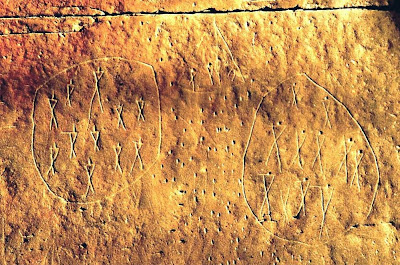When we look carefully at a rock art portrayal we can often find much more information than we expected at first glance. Keep looking.
Saturday, December 14, 2013
ARCHITECTURE IN ROCK ART, TIPIS - PART 2:
On November 30, 2013, I posted
part one of this column on tipi portrayals in rock art. In that posting I
talked about some examples found in southeastern Colorado rock art. In this
second visit to the subject I am going to introduce one of the most complex
rock art panels known that portrays a single subject, the Battle Scene panel at
Writing-on-Stone. Writing-on-Stone
Provincial Park / Áísínai'pi National Historic Site. Set in the prairie
grasslands of southern Alberta, Writing-on-Stone / Áísínai'pi is a sacred
landscape in the Milk River valley and contains possibly the largest
concentration of First Nation petroglyphs (rock carvings) and pictographs (rock
paintings) on the great plains of North America.
Left side of Battle Scene panel, Writing-on-stone Provincial
Park, Keyser and Klassen, 2001, fig. 14.33, p. 254.
“The name Áísínai’pi which is Niitsítapi (Blackfoot) meaning “it is
pictured / written”. Writing-on-Stone
Park contains the greatest concentration of rock art on the North American Great Plains.
There are over 50 petroglyph sites and thousands of works. There is
evidence that the Milk River Valley was inhabited by native people as long ago
as 9000 years. Native tribes such as the Blackfoot probably created much of the rock carvings (petroglyphs) and paintings (pictographs).
Other native groups such as the Shoshone also travelled through the valley and may have also created
some of the art. Beginning about 1730, large numbers of horses, metal goods,
and guns began to appear on the Western plains. This signified not only a
change in the native lifestyle, but a change in the content of the rock art.
Pictures of hunters on horseback, and warriors without body shields began to be
created.” (Wikipedia 2013)
Battle scene panel, faintly scratched, very hard-to-see. http://digipac.cablog/20130907/writing
-on-stone-provincial-park-september-7.
This panel was described by James Keyser and Michael Klassen
(2001).
“Biographic rock art
reached its zenith with the Battle Scene panel at Writing-on-stone. It includes
the greatest number of figures in the most complex composition of any
Northwestern Plains rock art scene. Its detail and complexity clearly suggest that
it depicts an actual historical event, possibly linked to a famous battle
fought along the Milk River in 1866. The Battle Scene shows
a large group of pedestrian warriors attacking a large camp circle of tipis
(fig. 14.33). In the camp are several groups of humans, including three figures
inside the largest, central tipi. At the camp perimeter a row of fourteen guns,
two held by humans, represents warriors defending the camp. The attacking party
consists of an advance guard of more than a dozen armed warriors, followed by
more than three dozen pedestrian figures. Several rearguard figures carry bows
or guns, and at least eight lead horses, six of which pull travois. A stream of
bullets issues from the muzzle of nearly every gun in the scene.” (Keyser
and Klassen 2001:254)
Same battle scene, Writing-on-stone Provincial Park, Canada.
Scene of center of the camp on the left side with 3
figures in tipi in upper center. Strongly side lighted.
“This scene may relate
to a battle described in 1924 by a Piegan elder named Bird Rattle. In his
story, he directly linked the rock art of Writing-on-stone to the “Retreat up
the Hill” battle fought somewhere along the Milk River in 1866. In the fall of
that year, the Piegan winter camps filled all the coulees between the Milk
River and the Sweetgrass Hills.” (Keyser and Klassen 2001:255) Note that the village of tipis that is being attacked in the Battle Scene is pictured as a rough ring of triangular shapes with the tips pointing in.
Tipis, 39FA7, Sundstrom, Fig. 1.13, p.18.
Linea Sundstrom has identified portrayals of tipi or wickiup
shaped structures from the Black Hills region. ”Two tipis are visible among the confused array of lines on this rock
art panel from site 39FA7 in the southern Black Hills.” (Sundstrom 2004:18)
Sundstrom has also identified a handful of sites in the north Cave Hills where
she believes there are portrayals of tipi-shaped eagle trapping lodges.
(Sundstrom 2004:119)
Tipi village in upper center.Taylor, Buckskin and
Buffalo, p.47. The circle of triangles in the upper
center represents a tipi village.
“A large tanned steer
hide painted in the spring of 1892 by the Piegan artist Sharp. – The
pictographs, in a style typical of the Blackfeet of this period, mainly
document the military exploits of White Grass, a highly respected chief of the
Buffalo Chip band of the Piegan, who was involved in many actions against such
tribes as the Flathead and Pend D'Oreilles of the Plateau region to the west of
Blackfeet territory. Here, White Grass is about to enter the Flathead circle of
tipis to cut free the two picketed horses at the very heart of the encampment.
He also captures the enemy chiefs bow, arrows, and quiver.” (Taylor 1998:47)
Tipi village by Piegan artist Sharp, 1892.Taylor, Buckskin and
Buffalo, p.47.
When we look carefully at a rock art portrayal we can often find much more information than we expected at first glance. Keep looking.
REFERENCES:
Keyser,
James D. and Michael A. Klassen
2001 Plains
Indian Rock Art, University of Washington Press, Seattle.
Sundstrom,
Linea
2004 Storied Stone: Indian Rock
Art of the Black Hills, University of Oklahoma Press, Norman.
Taylor, Colin
1998 Buckskin and Buffalo, the
Artistry of the Plains Indians, Rizzoli, New York.
Subscribe to:
Post Comments (Atom)










No comments:
Post a Comment